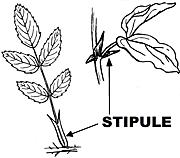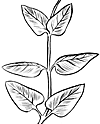Manono
Kadua affinis
Madder family (Rubiaceae)
Native species ()
The Kadua, common name manono, is known only from Hawaii and has numerous variations of shrubs and small trees grouped into four species. This species has many varieties and forms. Plants of this have paired short-stalked leaves mostly small, oblong, and leathery, with paired blunt that shed early, clusters of many small greenish flowers with four meeting at edges in bud, and small round bluish black two-celled and many-seeded.

©2005 Forest And Kim Starr
Leaves with short leaf-stalks less than 3⁄8 inch (1 ) long and paired small blunt that shed early. Blades mostly oblong, 2–4 inches (5–10 ) long and 1–1 3⁄4 inches (2.5–4.5 ) wide, thick and leathery, blunt or short-pointed at both ends, turned under at edges, above shiny green with few inconspicuous curved side veins, beneath dull light green and often slightly hairy.
Flower clusters () branched, 1–2 inches (2.5–5 ) long, mostly Flowers many, short-stalked, about 3⁄8 inch (10 ) long, composed of greenish base () 1⁄8 inch (3 ) long; four- greenish purplish green 1⁄4–3⁄8 inch (6–10 ) long with narrow tube and four narrow tube and four narrow spreading overlapping in bud; four short within tube near end; and with inferior two-celled many ovules in each cell, and slender two- at end.
(berries) are round, 1⁄4–3⁄8 inch (6–10 ) in diameter, bluish black, with teeth at two-celled and many-seeded.
Wood light brown, hard. Uses by Hawaiians were for canoe trim and rigging, none at present.
Widespread in wet forests through the islands, mainly at 900–6700 ft (274–2042 ) elevation.
Special areas
Kokee, Volcanoes
Champion
Height 20 ft (6.1 ), c.b.h. 3 ft (0.9 ), spread 12 ft (3.7 ). Hawaii Volcanoes National Park, Hawaii (1968).
Range
Hawaiian Islands only
Botanical
Gouldia affinis (DC.) Wilbur, Gouldia terminalis (Hook. & Arn.) Hillebr.









